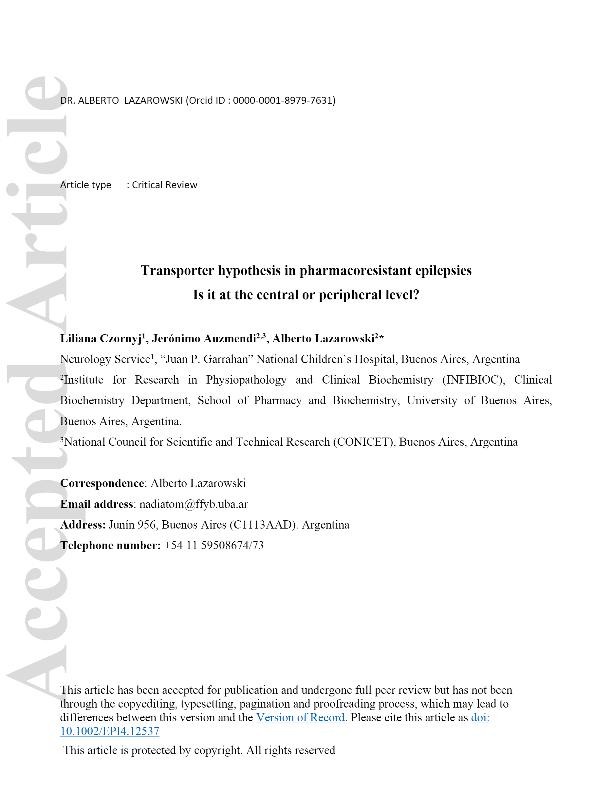Mostrar el registro sencillo del ítem
dc.contributor.author
Czornyj, Liliana
dc.contributor.author
Auzmendi, Jerónimo Andrés

dc.contributor.author
Lazarowski, Alberto Jorge

dc.date.available
2022-05-11T10:18:18Z
dc.date.issued
2021-09
dc.identifier.citation
Czornyj, Liliana; Auzmendi, Jerónimo Andrés; Lazarowski, Alberto Jorge; Transporter hypothesis in pharmacoresistant epilepsies Is it at the central or peripheral level?; John Wiley & Sons Inc.; Epilepsia Open; 9-2021; 1-34
dc.identifier.issn
2470-9239
dc.identifier.uri
http://hdl.handle.net/11336/157165
dc.description.abstract
The multidrug resistance (MDR) phenotype is typically observed in patients with refractory epilepsy (RE) whose seizures are not controlled despite receiving several combinations of more than two antiseizure medications (ASMs) directed against different ion channels or neurotransmitter receptors. Since the use of bromide in 1860, more than 20 ASMs have been developed; however, historically ~30% of cases of RE with MDR phenotype remains unchanged. Irrespective of metabolic biotransformation, the biodistribution of ASMs and their metabolites depends on the functional expression of some ATP-binding cassette transporters (ABC-t) in different organs, such as the blood-brain barrier (BBB), bowel, liver, and kidney, among others. ABC-t, such as P-glycoprotein (P-gp), multidrug resistance-associated protein (MRP-1), and breast cancer-resistance protein (BCRP), are mainly expressed in excretory organs and play a critical role in the pharmacokinetics of all drugs. The transporter hypothesis can explain pharmacoresistance to a broad spectrum of ASMs, even when administered simultaneously. Since ABC-t expression can be induced by hypoxia, inflammation, or seizures, a high frequency of uncontrolled seizures increases the risk of RE. These stimuli can induce ABC-t expression in excretory organs and in previously non-expressing (electrically responsive) cells, such as neurons or cardiomyocytes. In this regard, an alternative mechanism to the classical pumping function of P-gp indicates that P-gp activity can also produce a significant reduction in resting membrane potential (ΔΨ0 = -60 to -10 mV). P-gp expression in neurons and cardiomyocytes can produce membrane depolarization and participate in epileptogenesis, heart failure, and sudden unexpected death in epilepsy. On this basis, ABC-t play a peripheral role in controlling the pharmacokinetics of ASMs and their access to the brain and act at a central level, favoring neuronal depolarization by mechanisms independent of ion channels or neurotransmitters that current ASMs cannot control.
dc.format
application/pdf
dc.language.iso
eng
dc.publisher
John Wiley & Sons Inc.

dc.rights
info:eu-repo/semantics/openAccess
dc.rights.uri
https://creativecommons.org/licenses/by/2.5/ar/
dc.subject
TRANSPORTER HYPOTHESIS
dc.subject
REFRACTORY EPILEPSY
dc.subject
CENTRAL ACTIVATION
dc.subject
MEMBRANE DEPOLARIZATION
dc.subject
SUDDEN UNEXPECTED DEATH IN EPILEPSY (SUDEP)
dc.subject.classification
Neurociencias

dc.subject.classification
Medicina Básica

dc.subject.classification
CIENCIAS MÉDICAS Y DE LA SALUD

dc.subject.classification
Bioquímica y Biología Molecular

dc.subject.classification
Ciencias Biológicas

dc.subject.classification
CIENCIAS NATURALES Y EXACTAS

dc.title
Transporter hypothesis in pharmacoresistant epilepsies Is it at the central or peripheral level?
dc.type
info:eu-repo/semantics/article
dc.type
info:ar-repo/semantics/artículo
dc.type
info:eu-repo/semantics/publishedVersion
dc.date.updated
2022-04-26T17:06:04Z
dc.journal.pagination
1-34
dc.journal.pais
Estados Unidos

dc.journal.ciudad
New Jersey
dc.description.fil
Fil: Czornyj, Liliana. Gobierno de la Ciudad de Buenos Aires. Hospital de Pediatría "Juan P. Garrahan"; Argentina
dc.description.fil
Fil: Auzmendi, Jerónimo Andrés. Consejo Nacional de Investigaciones Científicas y Técnicas. Oficina de Coordinación Administrativa Houssay. Instituto de Biología Celular y Neurociencia "Prof. Eduardo de Robertis". Universidad de Buenos Aires. Facultad de Medicina. Instituto de Biología Celular y Neurociencia; Argentina. Universidad de Buenos Aires. Facultad de Farmacia y Bioquímica. Instituto de Fisiopatología y Bioquímica Clínica; Argentina
dc.description.fil
Fil: Lazarowski, Alberto Jorge. Universidad de Buenos Aires. Facultad de Farmacia y Bioquímica. Instituto de Fisiopatología y Bioquímica Clínica; Argentina
dc.journal.title
Epilepsia Open
dc.relation.alternativeid
info:eu-repo/semantics/altIdentifier/url/https://onlinelibrary.wiley.com/doi/10.1002/epi4.12537
dc.relation.alternativeid
info:eu-repo/semantics/altIdentifier/doi/http://dx.doi.org/10.1002/epi4.12537
Archivos asociados
